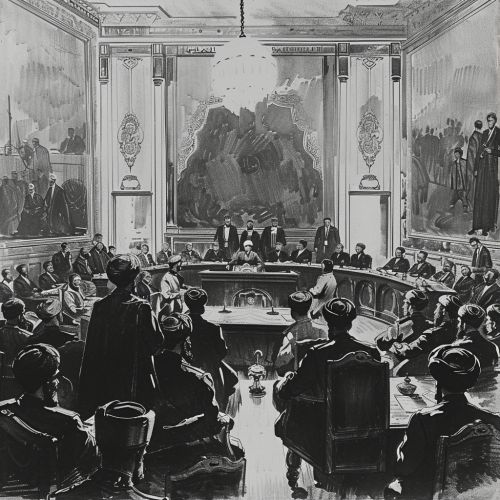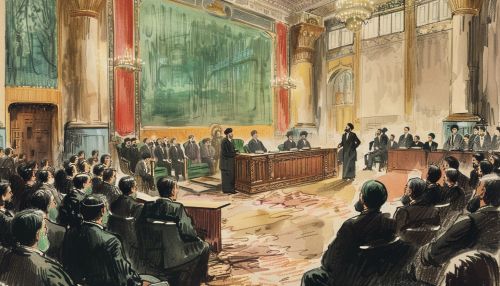Constitutional Revolution of Iran
Background and Context
The Constitutional Revolution of Iran (1905-1911) was a pivotal event in the history of modern Iran, marking the transition from centuries of absolute monarchy to a constitutional monarchy. This revolution was driven by a complex interplay of internal discontent, external pressures, and the influence of modernist ideas. The revolution led to the establishment of a parliament (Majlis) and the drafting of the first constitution of Iran, which aimed to limit the powers of the Shah and introduce a system of checks and balances.
Causes of the Revolution
Internal Discontent
The late 19th and early 20th centuries were a period of significant social and economic upheaval in Iran. The Qajar dynasty, which had ruled Iran since the late 18th century, was increasingly seen as corrupt and ineffective. The Shahs were criticized for their lavish lifestyles and their inability to address the country's economic problems. High levels of taxation, widespread poverty, and the arbitrary rule of local governors fueled widespread discontent among various social classes, including the clergy, merchants, and intellectuals.
External Pressures
Iran's geopolitical position made it a focal point of interest for major powers such as Russia and Great Britain. Both countries sought to expand their influence in Iran, leading to a series of concessions and treaties that undermined Iran's sovereignty. The Treaty of Turkmenchay (1828) and the Anglo-Persian Oil Agreement (1901) are notable examples. These agreements granted significant economic and political privileges to foreign powers, further exacerbating domestic discontent.
Influence of Modernist Ideas
The late 19th century saw the rise of modernist and nationalist ideas in Iran, influenced by the Tanzimat reforms in the Ottoman Empire and the Meiji Restoration in Japan. Iranian intellectuals and reformists, many of whom had been educated abroad, began to advocate for constitutionalism, rule of law, and the establishment of modern institutions. Newspapers and pamphlets played a crucial role in spreading these ideas, leading to the formation of secret societies and political groups that sought to challenge the status quo.
Key Events
The Tobacco Protest (1891-1892)
One of the early precursors to the Constitutional Revolution was the Tobacco Protest, a nationwide movement against the granting of a tobacco concession to a British company. The protest was led by the clergy and merchants and succeeded in forcing the Shah to cancel the concession. This event demonstrated the potential for collective action and set the stage for future mobilizations.
The Outbreak of the Revolution (1905)
The immediate trigger for the Constitutional Revolution was the brutal treatment of merchants in Tehran by the governor of the city. This incident led to widespread protests and strikes, culminating in the establishment of a "House of Justice" (Edalatkhaneh) in 1906. The protests quickly spread to other cities, and under mounting pressure, Shah Mozaffar ad-Din Shah Qajar agreed to convene a national assembly to draft a constitution.
The Establishment of the Majlis (1906)
In August 1906, the first Majlis (parliament) was convened, and by December of the same year, the first constitution of Iran was ratified. The constitution established the framework for a constitutional monarchy, with the Majlis holding legislative powers and the Shah's authority being significantly curtailed. The constitution also included provisions for civil liberties, such as freedom of speech and assembly.


The Reign of Mohammad Ali Shah (1907-1909)
The death of Mozaffar ad-Din Shah in 1907 and the accession of his son, Mohammad Ali Shah, marked a period of intense conflict. Mohammad Ali Shah was opposed to the constitutional movement and sought to restore absolute monarchy. In June 1908, he ordered the bombardment of the Majlis building and the arrest of leading constitutionalists. This led to a civil war between the Shah's forces and the constitutionalists, who were supported by various regional militias.
The Triumph of the Constitutionalists (1909)
By mid-1909, the constitutionalist forces had gained the upper hand. They captured Tehran and deposed Mohammad Ali Shah, replacing him with his young son, Ahmad Shah Qajar. A second Majlis was convened, and efforts were made to consolidate the gains of the revolution. However, internal divisions and external pressures continued to pose significant challenges.
Impact and Legacy
Political Reforms
The Constitutional Revolution led to significant political reforms, including the establishment of a bicameral legislature and the introduction of modern legal codes. The judiciary was reformed to ensure greater independence, and efforts were made to modernize the administrative apparatus of the state. However, the implementation of these reforms was uneven, and many of the old power structures remained intact.
Social and Economic Changes
The revolution also had a profound impact on Iranian society. The spread of modernist ideas and the establishment of new educational institutions contributed to the rise of a new intellectual and professional class. Economic reforms aimed at reducing foreign influence and promoting domestic industries were introduced, although their success was limited by ongoing political instability.
Influence on Future Movements
The Constitutional Revolution served as a model for subsequent political movements in Iran. The ideals of constitutionalism and nationalism continued to inspire future generations, including the leaders of the Iranian Revolution of 1979. The revolution also highlighted the importance of popular mobilization and the potential for collective action to bring about political change.
Challenges and Limitations
Internal Divisions
One of the major challenges faced by the constitutionalists was internal divisions. The movement was a coalition of diverse groups with differing agendas, including secular intellectuals, clergy, merchants, and regional leaders. These divisions often led to conflicts and hindered the ability to implement reforms effectively.
External Interference
The geopolitical interests of foreign powers continued to pose significant challenges. Both Russia and Britain intervened in Iranian affairs to protect their interests, often supporting reactionary elements to undermine the constitutional movement. The Anglo-Russian Convention of 1907, which divided Iran into spheres of influence, further complicated the situation.
Economic Constraints
The economic situation in Iran remained precarious throughout the revolutionary period. The country was heavily indebted to foreign powers, and efforts to modernize the economy were hampered by a lack of resources and infrastructure. High levels of poverty and unemployment persisted, contributing to social unrest.
Conclusion
The Constitutional Revolution of Iran was a landmark event that set the stage for the modernization of the Iranian state and society. Despite its many challenges and limitations, the revolution succeeded in establishing the principles of constitutionalism and popular sovereignty. Its legacy continues to shape the political landscape of Iran to this day.
